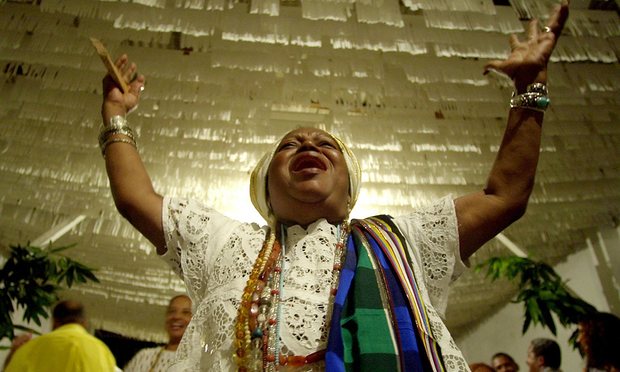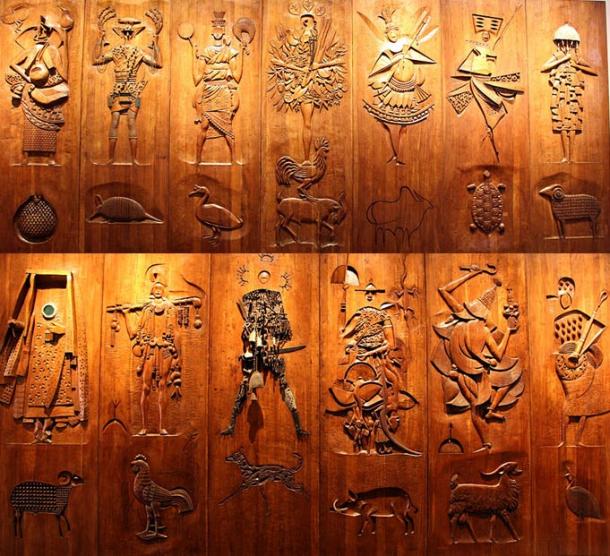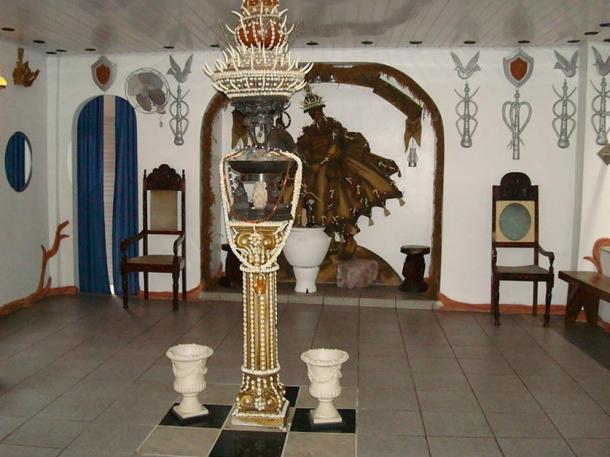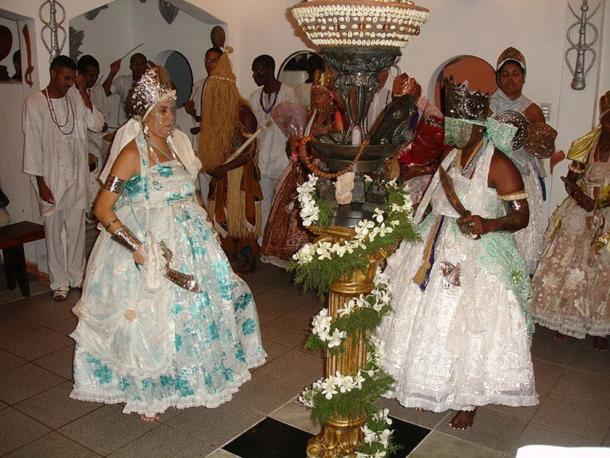Candomblé: Dance of the Orixás in Modern Day Bahia, Brazil
by Elaine Lee
It was a summer Sunday evening in the Federaco hillside neighborhood of Salvador, Bahia where warm sea breezes gently enveloped us as we journeyed into a large open-aired whitewashed stucco temple (terreiro), to attend a traditional Afro-Brazilian Candomble ceremony.
Within moments of arriving we got the distinct impression that we were in for an exciting, enriching and otherworldly experience. Incense filled the air, large golden ornaments hung from the ceiling and ornate murals covered the walls. In one corner was an elaborate altar laden with brilliantly colored artifacts, figurines, candles and vases of flowers and in the other corner, a spirited cadre of male drummers, beating out innovative and infectious rhythms.
Threading our way through the crowd of fifty or so neighborhood folk, initiates and tourists, we found seats on the bleacher-like benches nestled along the back wall.
afro-brazilian tours
Orixas, deities of the Candomble religion, have been built in Salvador, northeastern Brazil
AAA worshipper lies on the floor after falling into a trance during a Candomble ceremony in Cachoeira brazil. (Photo by Mario Tama/Getty Images)

A Baiana woman performs the ritual dance in honor to Omolú, the Candomblé spirit syncretized with Saint Lazarus, inside the St Lazarus church in Salvador, Brazil. (Photograph: Jan Sochor/CON/LatinContent/Getty)
Emerging slowly from a doorway on the opposite side of the large ceremonial hall, one by one, a line of 23 women sinuously sauntered into the center of the room. Clad in immaculate white garb they quietly chanted and danced in unison until they made a large circle in the middle of the floor.
Their floor-length cotton skirts covered many layers of elaborate petticoats, their puff-sleeved blouses were covered by sashes that bound their chest, their heads were wrapped in a variety of intricate turban styles and each wore a wide array of brightly colored glass bead necklaces.
In concert with the drumbeats, their undulating movements and African chants steadily increased in pace during the hour-long preparatory period wherein the priestesses were calling to the orixas, ancestral African spirits, inviting them down into the sacred space.
Many members of the audience begin clapping and chanting when several of the priestesses begin to shout, spin and stagger. As they entered the trance state, their actions were very reminiscent of what people of the African American Pentecostal tradition called “gittin’ the Holy Ghost”.
A couple of them fell on the floor appearing to be ridden by a spirit/orisha and while several others laid trembling as if they were experiencing a full body nervous spasm.
At the first sign of spirit possession, several of the non-possessed priestesses rush to the aid of the possessed. They guided them past the leader of the terreiro, the Mae de Santo who sat regally in her throne-like chair, surrounded by her assistants.
She appeared to give them some kind of blessing or acknowledgement and then the attendees whisked them off to be clad in clothes and symbols befitting that particular orixa of which they were inhabited.
Shortly thereafter, the possessed are returned in full regalia with an accompanying entourage to assist them in making their ritual journey, salutes and bows to various people and sites within and without the temple as well as to bestow blessings to those in need of assistance from that particular orixa.
Other priestesses, priests and initiates began to join in the circle dance, as it continued to swirl around the room, intensifying in energy and volume.
During our visit, we witnessed the descension of Omolú, the god of sickness/health, with his straw hat, mask and wooden wand, Oxossi, the god of the forest and hunt, with his bow and arrow and Yansa, the goddess of rain and wind, with her shimmering and swaying beaded veil, sword and whisk made from what appeared to be an oxtail.
The portion of the ceremony that we witnessed is just one small aspect of the complex world of Candomble, which is alive and well in modern day Brazil and is actively practiced by tens of millions of Brazilians. The government estimates that in Brazil, there are over 300,000 terreiros, (centers of worship for traditional Afro-Brazilian religion).
In Salvador, Bahia the epicenter of Candomble, there are over 4,000 terreiros and approximately 360 churches. Even though Brazil is the largest Catholic country in the world, where 80% of its 160 million population identify themselves as Catholic, it is estimated that almost 50% practice some form of African based religion and the remainder are touched and/or influenced by it. Many people practice both religions simultaneously or intermittently.
Other religions practiced include: Protestantism, Episcopalian, Methodist, Lutheran, Baptist, Mormonism, Islam, Judaism and Buddhism. There are over a million Spiritists or Kardescists, who follow the doctrines of its French founder, Allan Kardec.
There are numerous followers of Umbanda, which some consider to be a milder version of Candomble that was began to be widely embraced by the middle and upper classes of Brazil in the 1930’s, who were repelled by the coarseness of the standard Candomble rituals, which involved animal sacrifices.
Its religious philosophy is an amalgamation of African, Christian, Hindu, indigenous Indian, and spiritist beliefs. The Evangelical/Pentecostal religions are currently making aggressive inroads into the Candomble faithful yet the pervasiveness of the religion persists.
Africans brought Candomble to Brazil during the slave trade 1570 to 1851. The slaves were brought primarily from Angola, Congo, Guinea and Yoruba speaking West Africa to work on the plantations and in the mines.
Unlike the United States, many slave owners in Brazil, allowed the slaves to practice their traditional religion. Initially, they thought that the dance, songs and drumming of Candomble were nothing more than entertainment and nostalgia.
During the 17th century, the slave owners began the distrust the gatherings, as a possible means of organizing revolts and they began to prohibit the practice of traditional African religions.
In 1741, the pope deemed that slaves had souls that could be "saved", so Catholicism was promptly imposed upon them and they were urged to attend Catholic Church services.
Shortly thereafter, the slaves begin to develop a form of syncretism where they were able to retain much of their religious beliefs and customs by disguising them under the cloak of Catholicism.
They assigned the Catholic saints the role of different African deities.
For example, Saint George, the dragon slayer, was adopted to represent Oxossi, the orixa of the forest and the hunt; Saint Anthony, who was also given an honorary rank in the Portuguese Army, was chosen to represent Ogum, the orixa of iron and metalwork: Saint Lazarus the leper represented Omolú, the orixa of diseases; Yemanja, the mother goddess of the ocean, was likened to theVirgin Mary and Oxala, a male God of procreation and harvest was identified with Jesus.The slaves found other similarities between their religion and Catholicism:
- Both believe in a supreme being.
- The Orixas resemble Christian Saints, in that they were once people who led exceptional lives, and are usually given a single responsibility or special attribute.
- Both believe in an afterlife.
- Both have, as the centerpiece of some of their ceremonies, a ritual sacrifice and/or the consumption of flesh and blood.
- Both developed ways to address/handle invisible negative energy and/or malevolent spirits.
- Both believe that each person has a guardian deity, which corresponds to a Christian's patron saint and the Candomble belief that each person is attended and protected by an orixa from birth.
According to Rachel Harding, author of Thunder in the Refuge, Candomble’s survival was also in part a response to enslavement and resistance to dehumanization.
She emphasizes the 'communion/community; refuge/resistance and healing/redress' nature of Candomble, as a means to create an alternative sense of black identity under the oppression of slavery through the creation of a closed exclusivist 'space of blackness' as well as providing a direct connection and conduit to Brazilian’s slave’s African lineage.
Candomble’s collective efforts were used to mediate the destabilizing forces of slavery and race discrimination by fetishizing them--by reinscribing them as spirits that in some measure are subject to the individual's control through ritual means such as amulets, potions, spells, offerings, healing ceremonies, and divination practices.
Additionally, the spirit possession aspect of Candomble strengthened the identity and self-esteem of the practitioner by honoring him/her with a visit by the gods in their own bodies as well as the accompanying attention and reverence given them by other ceremony attendees.
One of the best examples of the survival of Candomble is the Sisterhood of the Boa Morte (Good Death), a woman’s association that was founded in the 1830’s near the city of Cachoeira, north of Salvador.
The Catholic Church viewed the group as a type of funerary women’s religious order when in fact the group’s primary purpose was that of helping free slaves and preserving cultural traditions.
Their annual festival coincides with that of the Feast of the Assumption of the Virgin Mary and continues to be one of the most important festivals in all of Bahia.
Their compound is one of the unofficial headquarter of Candomble in Brazil. After the end of chattel slavery in 1888, many Afro-Brazilians began reorganize their communities based on the regions of African from which they originated and they sought to revitalize their own traditional religions.
As a result three major types of Candomble emerged from four different African regions/nations (nações). There is the Gêgê-Nagô Candomblés, the Ketu-Nago, the Angola-Congo Candomblés, and the Candomblés de Caboclo.
The first two are based on the Dahomeyan and Yoruba religious tradition and language, while the other two are based on diverse Bantu and Brazilian sources. There is a great deal of variation and similarity between and within these four types of Candomble.
Several common rituals they share are:
- Ëbö is one of the most widely practiced rituals in Candomblé. There are many types of ëbö, such as pouring of water, giving of money, completing an onerous physical task or killing of an animal. It is thought that sacrifice that helps to get rid of negative energy and it gives power to one’s spiritual life.
- Bori is a ceremony where homage is paid to (or feed) to an Orixa. Meals are made of their favorite food and presented to them in a sacred space.
- Buzios are cowry shells are used in a divination ceremony where a Candomble priest or priestess throws them and then deciphers a spiritual message based on the shell’s arrangement. The message can reveal:
- A) Your individual destiny. Tradition states that each person from the moment of conception selects his/her destiny. One’s goal in life is to make sure they overcome the obstacles in their way and reach their destiny.
- B) What two deities/orixas guide one’s life. The first deity is considered the 'owner of your head', who gives strength and direction when you need it most. The second deity who is equally important, provides assistance.
- C) What ancestor guides your actions as well as the reading can facilitate the transmission of messages from the ancestors to person receiving the reading.
Visiting or living in the terreiro (temple/religious compound). Some followers will attend a terreiro only for a ceremony or consultation of the cowry shells; others will stay for many months and become inducted into a spiritual rebirth and possession by their orixa. Parts of the temple are open to visitors, others are reserved for the initiated.
To enter some terreiros you must follow certain protocol such as resting your body, splashing water to cool the entrance and release the negativity of the world outside.
Respect for elders and the sacred spaces are fundamental and visitors are expected to bow or salute specific parts of the terreirio, e.g. the grave/mausoleum of deceased leaders of that terreirio or the compound’s oroko tree.
Many also prohibit the wearing of black clothes. Our tour group was forbidden entrance into a terreirio’s ceremonial hall because all of us happened to be wearing black clothes.
(Each Candomble center functions independently and may evince slight variations in protocol. A substantial portion of doctrine and practice has been kept secret because of long years of suppression and persecution by local and federal governments).
The purpose of rituals and protocol is also to make contact with a spirit, to gain their favor, to obtain help in the form of more abundant food, higher standard of living, and improved health.
It is said that humans and Orixas depend upon each other; humans provide food and other materials; the orixas provide health, protection from evil spirits and good fortune.
Rituals are also held to celebrate events, to attempt to escape bad fortune, to celebrate a seasonal day associated with an orixa, for healing, at birth, marriage and/or death.
A century ago, Candomble was an unspoken secret in Brazil. For decades in 20th century, police routinely broke up Candomble ceremonies. Until 1976, celebrants were required to obtain permits from law enforcement.
Even as the Catholic Church complains anew about "syncretism" - the blending of African and Christian religious systems, the former secret religion is becoming a matter of public pride.
In 2000, Brazil’s Minister of Culture, Francisco Weffort, visited one of Salvador’s largest terreiros, Axe Opo Afonja, and declared that it was a national monument that should be protected.
“The event was a victory for Candomble followers,” said city councilman Juca Ferreira. “The state was saying it finally recognizes that not only Catholic churches are part of our national legacy and birthright”.
In another public display of the growing recognition of Candomble in Brazilian society, the city of Salvador erected eight, two ton, towering 22-foot statues of orixas in a lake in the center of downtown.
By night they are illuminated and appear to be float above the water in a circle as if they are dancing around a lighted fountain.
They stand as monuments to Brazil’s African heritage and the enduring nature of Candomble and Axe, the power of the orixas.
(Axe, pronounced ah-say, is also a popular salutation in Bahia, which loosely means, “may the force be with you”.)
Elaine Lee
Elaine Lee is a practicing attorney, accomplished traveler, travel journalist, travel blogger and editor of "Go Girl: The Black Woman's Book of Travel and Adventure" . A contributor to numerous national and local magazines, newspapers and webzines, Elaine's travel stories generally address subjects such as African American travel trends, adventure, women’s travel issues, spirituality, solo travel, health, budget travel and travel planning. Elaine has also contributed stories to five anthologies and two books. Visit Elaine's website at ugoggirl.com
Some of the Candomblé orixas. Museu Afro-Brasilero, Salvador-Bahia, Brazil.





